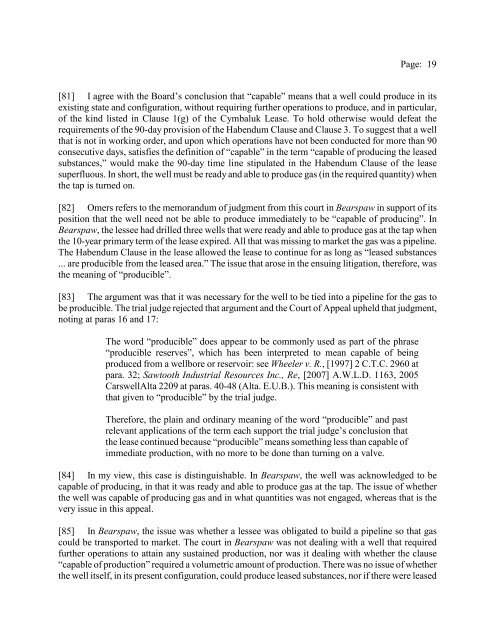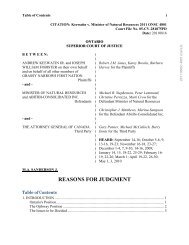Omers Energy Inc. v. Alberta (Energy Resources Conservation Board)
Omers Energy Inc. v. Alberta (Energy Resources Conservation Board)
Omers Energy Inc. v. Alberta (Energy Resources Conservation Board)
- No tags were found...
Create successful ePaper yourself
Turn your PDF publications into a flip-book with our unique Google optimized e-Paper software.
Page: 19[81] I agree with the <strong>Board</strong>’s conclusion that “capable” means that a well could produce in itsexisting state and configuration, without requiring further operations to produce, and in particular,of the kind listed in Clause 1(g) of the Cymbaluk Lease. To hold otherwise would defeat therequirements of the 90-day provision of the Habendum Clause and Clause 3. To suggest that a wellthat is not in working order, and upon which operations have not been conducted for more than 90consecutive days, satisfies the definition of “capable” in the term “capable of producing the leasedsubstances,” would make the 90-day time line stipulated in the Habendum Clause of the leasesuperfluous. In short, the well must be ready and able to produce gas (in the required quantity) whenthe tap is turned on.[82] <strong>Omers</strong> refers to the memorandum of judgment from this court in Bearspaw in support of itsposition that the well need not be able to produce immediately to be “capable of producing”. InBearspaw, the lessee had drilled three wells that were ready and able to produce gas at the tap whenthe 10-year primary term of the lease expired. All that was missing to market the gas was a pipeline.The Habendum Clause in the lease allowed the lease to continue for as long as “leased substances... are producible from the leased area.” The issue that arose in the ensuing litigation, therefore, wasthe meaning of “producible”.[83] The argument was that it was necessary for the well to be tied into a pipeline for the gas tobe producible. The trial judge rejected that argument and the Court of Appeal upheld that judgment,noting at paras 16 and 17:The word “producible” does appear to be commonly used as part of the phrase“producible reserves”, which has been interpreted to mean capable of beingproduced from a wellbore or reservoir: see Wheeler v. R., [1997] 2 C.T.C. 2960 atpara. 32; Sawtooth Industrial <strong>Resources</strong> <strong>Inc</strong>., Re, [2007] A.W.L.D. 1163, 2005CarswellAlta 2209 at paras. 40-48 (Alta. E.U.B.). This meaning is consistent withthat given to “producible” by the trial judge.Therefore, the plain and ordinary meaning of the word “producible” and pastrelevant applications of the term each support the trial judge’s conclusion thatthe lease continued because “producible” means something less than capable ofimmediate production, with no more to be done than turning on a valve.[84] In my view, this case is distinguishable. In Bearspaw, the well was acknowledged to becapable of producing, in that it was ready and able to produce gas at the tap. The issue of whetherthe well was capable of producing gas and in what quantities was not engaged, whereas that is thevery issue in this appeal.[85] In Bearspaw, the issue was whether a lessee was obligated to build a pipeline so that gascould be transported to market. The court in Bearspaw was not dealing with a well that requiredfurther operations to attain any sustained production, nor was it dealing with whether the clause“capable of production” required a volumetric amount of production. There was no issue of whetherthe well itself, in its present configuration, could produce leased substances, nor if there were leased
















